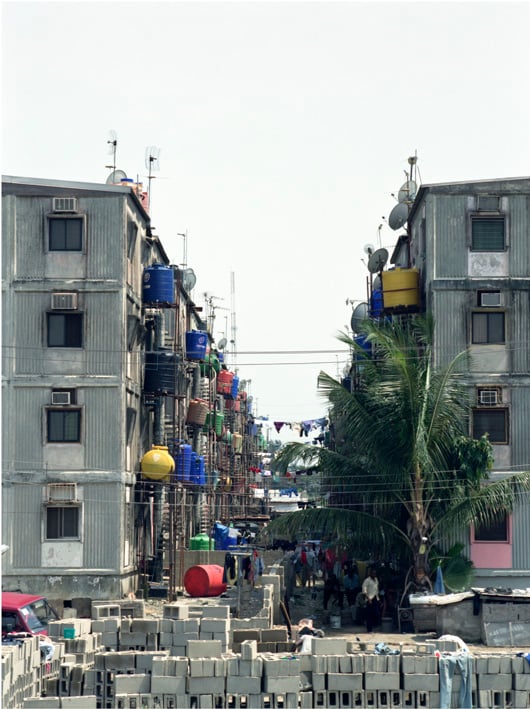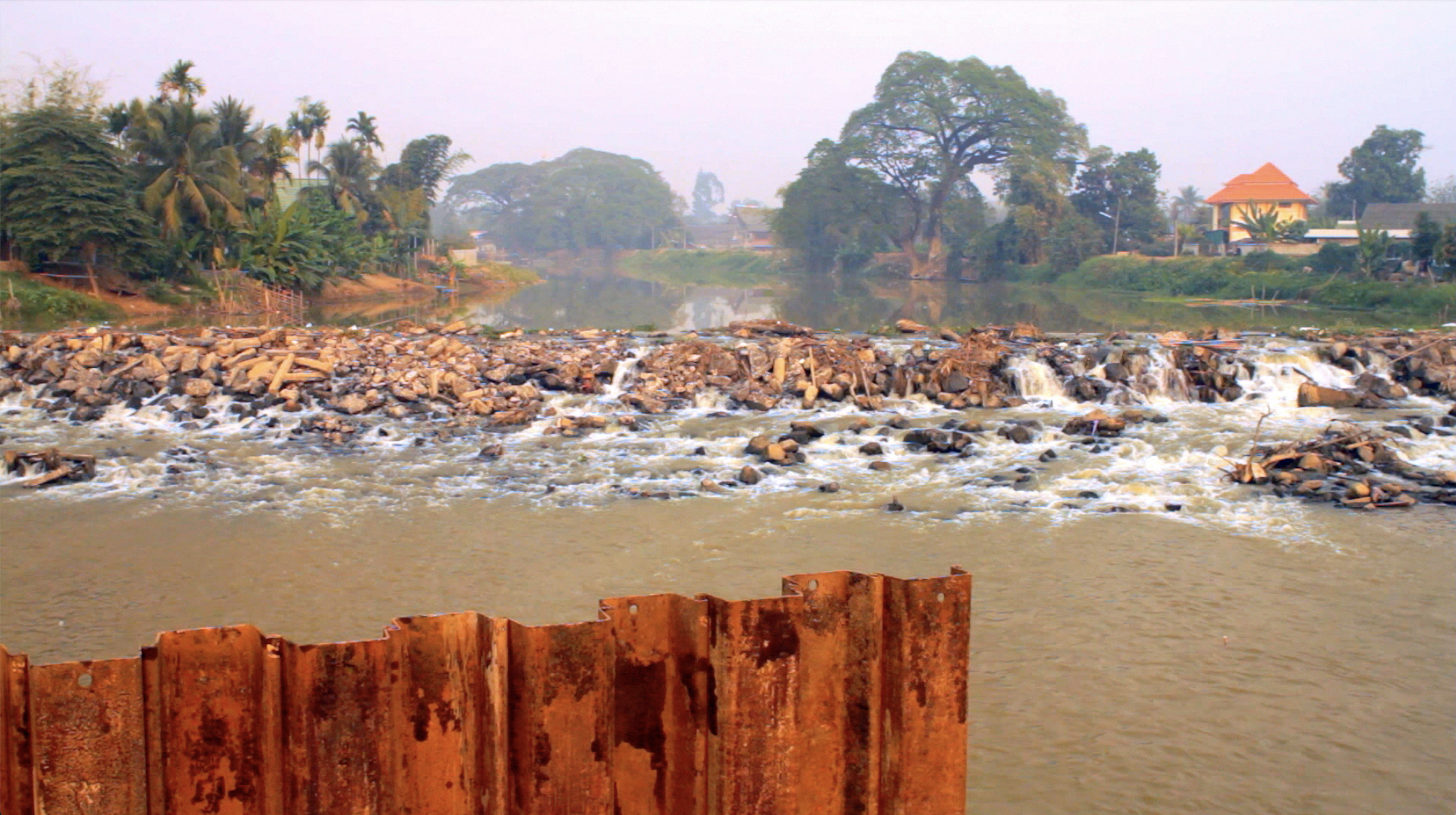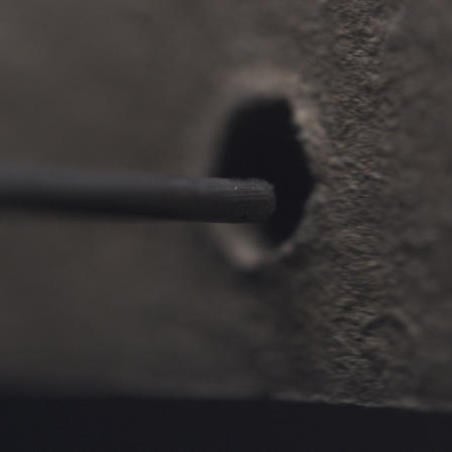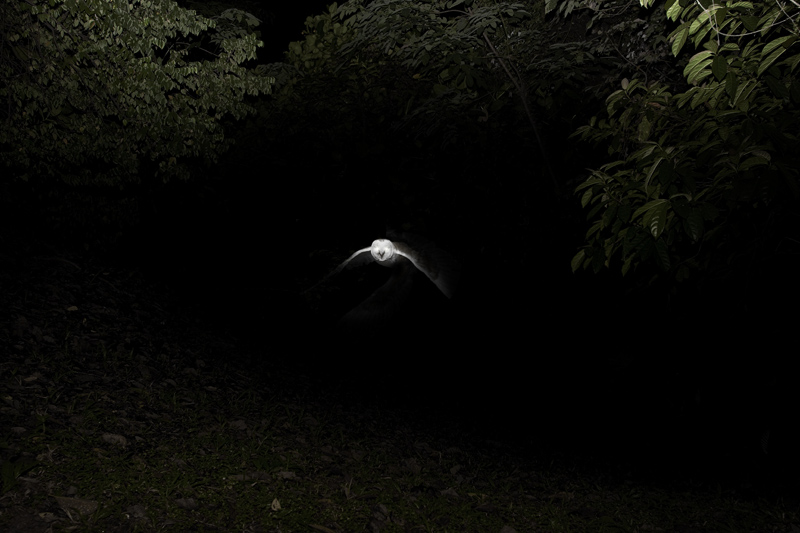
© » KADIST
Noara Quintana
The series Belle Époque of the Tropics by Noara Quintana has as its background the history of the rubber industrialization in North of Brazil. The so-called Amazon Rubber Boom, 1879 to 1912, was an important part of the economic and social history of the country and Amazonian regions of neighboring countries, related to the extraction and commercialization of latex. Centered in the Amazon river basin, the boom resulted in a large expansion of European colonization in the area, causing cultural and social transformations that wreaked havoc upon Indigenous societies and immense environmental damage.

© » KADIST
Zhou Tao
Created for the Seventh Shanghai Biennale at the Shanghai Art Museum, Zhou Tao’s 1,2,3,4 records morning staff meetings in over forty shops and companies in the immediate vicinity of the People’s Square. Regardless of occupation, the employees count off and move in step to the rhythms of their companies’ corporate songs or chants, which are meant to build team spirit and corporate loyalty. Zhou’s practice alchemizes the ordinary surroundings into a theatre where his camera is not simply a recording apparatus but an extension of existence.

© » KADIST
Otobong Nkanga
Tsumeb Fragments was produced for the exhibition at Kadist, “Comot Your Eyes Make I Borrow You Mine” in 2015. In Spring 2015, Nkanga travelled to Namibia, making her way along an almost entirely defunct railway line from Swakopmund to Tsumeb. The artist was intent on reaching The Green Hill in Tsumeb, an area renowned for its minerals, crystals and copper deposits.
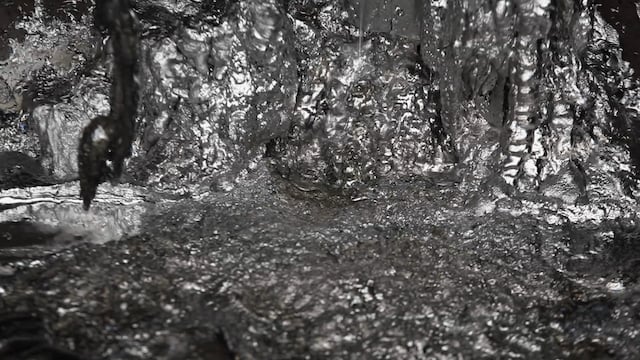
© » KADIST
Li Xiaofei
Argentum is part of Li Li Xiaofei’s Assembly Line series. The film was shot in Dongchuan, a small town 180 km from Kunming. Ten years ago, in order to attract foreign investment, Dongchuan officially became a district of Kunming, thus giving it access to preferential policies.

© » KADIST
Prabhakar Pachpute
“Dark Clouds Of The Future” is a cinematographic video animation of the abandoned gold mine in Brazil, Serra Pelada (“Naked Mountain”). Thought to be one of the largest mines in the world, made famous by the photographs Alfredo Jaar and later by Sebastião Salgado, the hand-dug mine is now a mercury-polluted lake. During his research trip to Brazil, Pachpute met many former gold diggers who used to work at Serra Pelada, inciting his interest in the concept of the witness.

© » KADIST
UuDam Tran Nguyen
Like many Asian countries, Vietnam has lost an immense amount of natural environment and rural landscape to economic growth and industrial development. The single-channel video Waltz of the Machine Equestrians is a response to the overwhelming number of motorbikes and scooters overtaking the streets of Vietnam as small agrarian communities have been displaced by the construction of skyscrapers. The video shows 28 “equestrians” on motorbikes and scooters arrayed into a rainbow cavalcade held together by strings clipped onto brightly colored ponchos.

© » KADIST
Reyes Santiago Rojas
The work Sarta (String) by Reyes Santiago Roja is part of a larger series of works that examine the commercialization of the tobacco plant and its relationship to the meaning and use of tobacco by Native American tribes such as the Mayas, Aztecs, Incas or Tainos, which attributed spiritual qualities to tobacco such as the smoke carrying one’s thoughts and prayers to the sprits. In this work the artist studied the forms of tobacco leaves native to Latin America and recreated their shapes with commercial tobacco packaging from such global brands as Marlboro or Camel to the most popular Colombian brand Pielroja. The leaves made of the packaging material are lined up on a string as if they are hung out to dry as in traditional tobacco making processes.

© » KADIST
Som Supaparinya
When Need Moves the Earth is a three-channel video that combines elements of documentary footage, archival material and abstract aerial shots to encompass a painterly yet forthright exploration of a coal mine and a water dam in Thailand. A meditation on the impact of industrialization on the natural environment, the work highlights the drastic alterations that these operations leave in its place. Som Supaparinya’s work is often a commentary on political, social, and personal issues.
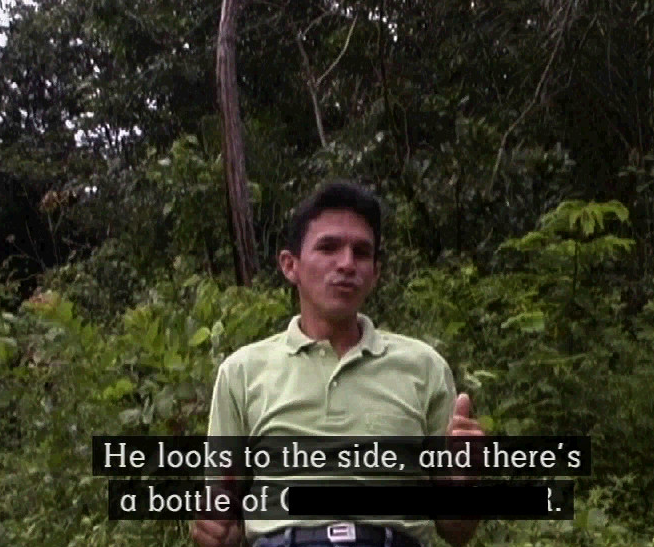
© » KADIST
SUPERFLEX
SUPERFLEX makes a distinction between two types of projects with different temporalities: works that occur during an exhibition and other that evolved over several years. Thus, since 1997, they are working on a biogas system (SUPERGAS), first installed in Kenya, then Thailand and today in Mexico, perfecting at each stage the means of production, utilization and commercialization of this system. GUARANA POWER is one of these sustainable projects that create a real economy.

© » KADIST
William E. Jones
In Restaurant, Canton, Ohio (2011), a convenience store offers food, liquor, and Coca Cola to an empty street. A series of boarded-up storefronts marred by peeling paint conveys a sense of the pre- or post-apocalyptic—the hush just before or after a disaster. The reds, pinks, and oranges of the buildings give off warmth, but the absence of human activity makes the glow eerie and strange.

© » KADIST
Ranu Mukherjee
Conceived as a large-scale mural-like projection, Color of History, Sweating Rocks is a neo-futuristic, hybrid film that combines cinematic language, collage, animation, and inventive forms to highlight the plight of the peoples of the Sahara—and refugees in general—who have been displaced by oil-mining.

© » KADIST
Sun Xun
Sun’s animated film 21 Ke (21 Grams) is based on the 1907 research by the American physician Dr. Duncan MacDougall who claimed the measured weight of the human soul to be twenty-one grams. Sun used this episode—which was not fully recognized by the scientific community—as a point of departure for his depiction of a dystopian world in which the narration of history and notion of time are interrupted. Because each frame was drawn by hand with crayon, it took Sun and his animation studio team a few years to complete this thirty-minute film of a surreal journey through mysterious cities, plagues of mosquitoes, broken statues, cawing ravens, waving flags, and flooded graveyards.

© » KADIST
Lu Chunsheng
Lu has developed an oeuvre that consists of characters in bizarre situations. The large-scale photograph I Want to Be a Gentleman depicts nine men standing like statues on display in a museum on tall plinths in front of a run-down industrial building. Lu’s brooding films and photographs are preoccupied with China’s industrial era and communist history.

© » KADIST
Tina Modotti
Modotti’s Diego Rivera Mural: Billionaires Club; Ministry of Education, Mexico D. F., Third Gallery is a photograph of a section of a mural by Diego Rivera in the Ministry of Education in Mexico City. Rivera painted over a hundred frescoes throughout the courtyard of the building, an early mural series that helped revive and popularize the art of mural painting. Modotti, a friend of Rivera’s, took hundreds of photographs of the frescoes which depict divisions of labor in Mexican society.

© » KADIST
Natasha Wheat
Drawing & Print (Drawing & Print)
Natasha Wheat’s Kerosene Triptych (2011) is composed of three images, one each from the digital files of the Library of Congress, the Smithsonian Institution, and the Field Museum tropical research archive. The original photographs were taken by anonymous photographers, not as art but as documents of the building of the Panama Canal. The laborers in the images are holding cans of kerosene and spraying it into the foliage.
Ranu Mukherjee
- location: San Francisco, California
- year born: 1966
- gender: female
- nationality: Indian
Otobong Nkanga
Visual artist and performer, Otobong Nkanga’s (b...
Sun Xun
- location: Hangzhou, China
- year born: 1980
- gender: male
- nationality: Chinese
- home town: Fuxin, Liaoning Provence, China
Tina Modotti
- location: Mexico City, Mexico
- year born: 1896
- gender: female
- nationality: Italian
- home town: Udine, Italy
Som Supaparinya
Humanity is not ontologically transcendent, artist Som Supaparinya’s work makes adamantly clear: actions energetically create impacts, experience dictated not only by our perceptions but equally the world that surrounds us, tethered inextricably...
Noara Quintana
Noara Quintana’s research-based practice focuses on the materiality of everyday objects and their interconnection with sociopolitical and historical processes in the Global South...
Prabhakar Pachpute
Prabhakar Pachpute calls attention to issues concerning land politics, industry, and labor through a multimedia practice that includes drawing, painting, sculpture, animation, and murals...
UuDam Tran Nguyen
- nationality: Vietnamese
Zhou Tao
Artist Zhou Tao has a diverse and varied practice, and notably, he denies the existence of any singular or real narrative or space...
SUPERFLEX
SUPERFLEX work on a number of projects linked to their avowed interest in political and social engagement on a local scale...
Reyes Santiago Rojas
Reyes Santiago Rojas works with themes relates to nature, patience and garbage...
Lu Chunsheng
- location: Shanghai, China
- year born: 1968
- gender: male
- nationality: Chinese
- home town: Changchun, Jilin province, China
Li Xiaofei
Li Xiaofei initiated Assembly Line in 2010, an ongoing project that records industrialized social change not only China, but as it occurs internationally...
-
1920-1929
Tina Modotti
1927Modotti’s Diego Rivera Mural: Billionaires Club; Ministry of Education, Mexico D...
-
2000-2009
-
2010-2019
William E. Jones
2011In Restaurant, Canton, Ohio (2011), a convenience store offers food, liquor, and Coca Cola to an empty street...
Ranu Mukherjee
2011Conceived as a large-scale mural-like projection, Color of History, Sweating Rocks is a neo-futuristic, hybrid film that combines cinematic language, collage, animation, and inventive forms to highlight the plight of the peoples of the Sahara—and refugees in general—who have been displaced by oil-mining....
Natasha Wheat
Drawing & Print
2011(Drawing & Print) Natasha Wheat’s Kerosene Triptych (2011) is composed of three images, one each from the digital files of the Library of Congress, the Smithsonian Institution, and the Field Museum tropical research archive...
UuDam Tran Nguyen
2012Like many Asian countries, Vietnam has lost an immense amount of natural environment and rural landscape to economic growth and industrial development...
Prabhakar Pachpute
2014“Dark Clouds Of The Future” is a cinematographic video animation of the abandoned gold mine in Brazil, Serra Pelada (“Naked Mountain”)...
Som Supaparinya
2014When Need Moves the Earth is a three-channel video that combines elements of documentary footage, archival material and abstract aerial shots to encompass a painterly yet forthright exploration of a coal mine and a water dam in Thailand...
Otobong Nkanga
2015Tsumeb Fragments was produced for the exhibition at Kadist, “Comot Your Eyes Make I Borrow You Mine” in 2015...
Reyes Santiago Rojas
2015The work Sarta (String) by Reyes Santiago Roja is part of a larger series of works that examine the commercialization of the tobacco plant and its relationship to the meaning and use of tobacco by Native American tribes such as the Mayas, Aztecs, Incas or Tainos, which attributed spiritual qualities to tobacco such as the smoke carrying one’s thoughts and prayers to the sprits...
Noara Quintana
2019The series Belle Époque of the Tropics by Noara Quintana has as its background the history of the rubber industrialization in North of Brazil...
